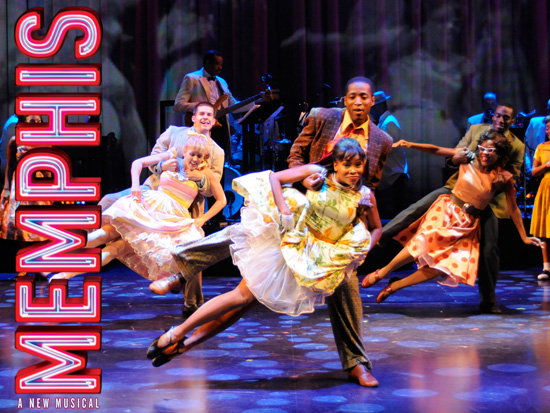
By Tracy E. Hopkins
Tony-award-winning musical “Memphis” is a revelation. Not only does it transport theatergoers to the underground rhythm and blues club scene and early days of rock and roll radio in 1950s Memphis, it also provokes dialogue about race relations.
The story revolves around Felicia, an attractive black blues singer ready for her big break (Tony nominee Montego Glover) and Huey (Tony nominee Chad Kimball), a quirky good ole’ boy who loves black music, or “race” music, as it was called during that era. Huey is lured to the downtown juke joint on “the dark side of town” by Felicia’s soulful voice. Felicia’s brother and the club’s owner, Delray (J. Bernard Calloway), is understandably suspicious of Huey, but he soon realizes his kinship with black music.
Early in the play, Huey loses his job as a record store clerk for playing black music. Eventually Huey becomes a DJ at a local radio station (he replaces a disc jockey who thinks Roy Rogers is an R&B artist), and another apprehensive boss chides him for playing race music. But young listeners love it and the station’s ratings peak, so Huey keeps his job and gives Felicia her first break, singing live on his radio show. They fall in love and Huey becomes so popular he gets his own TV show. He even recruits regulars from Delray’s club to sing and dance on air.
If Huey and Felicia were both white, they might live happily ever after. Huey’s mother, however, doesn’t approve of her son’s involvement with “that colored girl.” And Delray, aware of the dangers of the relationship, doesn’t like it either. Huey proposes, even though interracial marriage is illegal and unthinkable in the segregated South. Toward the end of the second act, a white mob spot the couple together and nearly beat Felicia to death while they hold Huey down and make him watch.
I’m an African-American woman married to an Italian-American man, so the racial issues addressed in “Memphis” hit particularly close to home. I live in New York City, where Felicia yearns to escape to, so that she and Huey can be together openly and she can sign a contract with a major record label. And as much as I would love to say interracial couples in the United States no longer struggle with the same prejudice depicted in the play, unfortunately some people still can’t see beyond the race.
Recently a well-intentioned girlfriend expressed how great it is that my marriage is going strong, because after all, “you’re black” and “he’s white.” You’d think by now, all that would matter are a soul connection and a person’s heart. But that’s not true now or during the era of the play. The challenges that Felicia and Huey face threaten to drive them apart.
As much as the love story moved me, the musical’s faith-based message delivered through rousing blues and gospel numbers brought me to tears. On the choir-backed rendering of “Love Will Stand Where All Else Fails,” Felicia testifies: “Now I see!/There’s only one way live/ Be kind and forgive/ I have the power in me!” Even Huey’s bigoted mother catches the Holy Ghost after visiting a black church. In “Change Don’t Come Easy,” she sings: “I was taught to hate them, was taught to denigrate them/ …they’re lesser in the good Lord’s eyes/ Can’t drink from the same fountain/ I’ll scream it from the mountain!/ I’m through listening to their blasphemous lies!”
“Memphis” delivers the message that love, faith, and forgiveness is the balm that heals hatred. I hope everyone who sees it (and everyone should see it) leaves feeling spiritually uplifted and hopeful that one day the content of our character will truly matter more than the color of our skin.
Tracy Hopkins is a lifestyle and entertainment writer whose work has appeared in numerous national publications and magazines. She also blogs at Everythingshewants.net.


